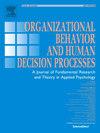Triangulating decision-making via choices, eye fixations, and reaching trajectories
IF 3.8
2区 管理学
Q2 MANAGEMENT
Organizational Behavior and Human Decision Processes
Pub Date : 2025-06-18
DOI:10.1016/j.obhdp.2025.104421
引用次数: 0
Abstract
People often face choices that involve tradeoffs over time or under uncertainty. While these decisions have been widely studied, most research focuses on the final choice rather than the process leading to it. In this paper, we combine two process-tracing tools, eye-tracking and mouse cursor tracking, to observe how decisions unfold in real time. Across two incentive-compatible experiments, we find that both visual attention and mouse movements predict choice, and together they provide complementary, non-overlapping insights. These tools also reveal how seemingly minor factors, such as where information appears on a computer screen, can influence decisions. By capturing the dynamics of the decision-making process, this approach offers valuable implications for organizations aiming to better understand, predict, or shape behavior.
通过选择、注视和到达轨迹来三角化决策
人们经常面临的选择涉及到随着时间的推移或不确定性的权衡。虽然这些决策已被广泛研究,但大多数研究关注的是最终选择,而不是导致最终选择的过程。在本文中,我们结合了两种过程跟踪工具,眼球跟踪和鼠标光标跟踪,来观察决策是如何实时展开的。在两个激励相容的实验中,我们发现视觉注意力和鼠标移动都能预测选择,它们一起提供了互补的、不重叠的见解。这些工具还揭示了看似微不足道的因素,比如信息出现在电脑屏幕上的位置,是如何影响决策的。通过捕捉决策过程的动态,这种方法为旨在更好地理解、预测或塑造行为的组织提供了有价值的暗示。
本文章由计算机程序翻译,如有差异,请以英文原文为准。
求助全文
约1分钟内获得全文
求助全文
来源期刊
CiteScore
8.90
自引率
4.30%
发文量
68
期刊介绍:
Organizational Behavior and Human Decision Processes publishes fundamental research in organizational behavior, organizational psychology, and human cognition, judgment, and decision-making. The journal features articles that present original empirical research, theory development, meta-analysis, and methodological advancements relevant to the substantive domains served by the journal. Topics covered by the journal include perception, cognition, judgment, attitudes, emotion, well-being, motivation, choice, and performance. We are interested in articles that investigate these topics as they pertain to individuals, dyads, groups, and other social collectives. For each topic, we place a premium on articles that make fundamental and substantial contributions to understanding psychological processes relevant to human attitudes, cognitions, and behavior in organizations. In order to be considered for publication in OBHDP a manuscript has to include the following: 1.Demonstrate an interesting behavioral/psychological phenomenon 2.Make a significant theoretical and empirical contribution to the existing literature 3.Identify and test the underlying psychological mechanism for the newly discovered behavioral/psychological phenomenon 4.Have practical implications in organizational context

 求助内容:
求助内容: 应助结果提醒方式:
应助结果提醒方式:


